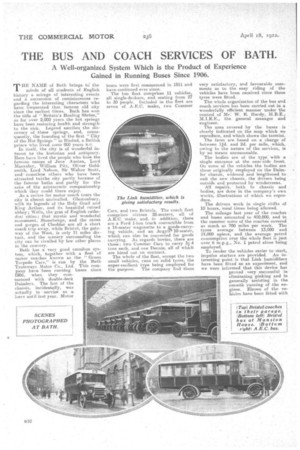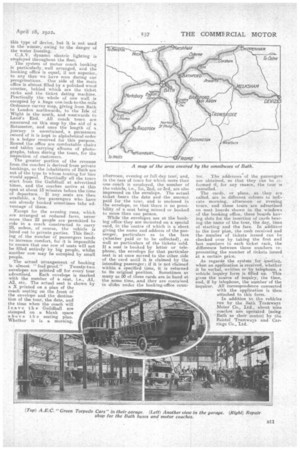THE BUS AND COACH SERVICES OF BATH.
Page 10

Page 11

If you've noticed an error in this article please click here to report it so we can fix it.
A Weil-organized System Which is the Product of Experience Gained in Running Buses Since 1906.
THE NAME of Bath brings to the minds of all students of English history a mirage of interesting events and a succession of reminiscences regarding the interesting characters who have. frequented that famous old city since the earliest times. Bath has won the title of " Britain's Healing Shrine," as for over 2,000 years the hot springs have been restoring health and strength to the sick. Legend ascribes the discovery of these springs, and, consequently, the founding of the first " City of the Hot Springs" to Bladud, a British prince who lived some 800 years B.C.
In itself, the city is of wonderful interest to the historian and antiquary. Here have lived the people who bore the famous names of Jane Austen, Lord Macaulay, William Pitt, Oliver Goldsmith, Lord Nelson, Sir Walter Scott, and countless others who have been attracted tre'ithe city partly because of the famous baths and partly for the sake of the aristocratic companionship which they could there enjoy.
As a centre for motor coach tours the city is almost unrivalled. Glastonbury, with its legends of the Holy Grail and King Arthur, and its beautiful ruined abbey ; Wells, the gem of English cathedral cities; that mystic and wonderful monument, Stonehenge, and the caves and gorges of Cheddar are all a short coach trip away, while Bristol; the gateway of the West, is only 11 miles distant, and the scenery surrounding the city UM be rivalled by few other places in the country.
Bath has a very good omnibus system, which, together with a fleet of motor coaches known as the " Green' Torpedo Cars," is run by the Bath Tramways Motor Co., LW. This pany have been running buses 1906, when they commenced with double-deck Daimlers. The last of the chassis, incidentally, was actually in service as a lorry until last year. Motor tours were first commenced in 1911 and have continued ever since.
The bus fleet comprises 11 vehicles, all single-deckers, and seating from 27 to 30 people. Included in the fleet are seven of A.E.C. make, two Commer Cars, and two Bristols. The coach fleet comprises sixteen 28-seaters, all of A.E.C. make, and, in addition, there are a Ford 14on. truck convertible from a 14-seater wagonette to a gni:As-carrying vehicle, and an Argyll 10-seater, which can also be converted for goods carrying. As regards lorries, there are three: two Commer Cars to carry 3-4 tons each, and one Dennis, all of which are hired out on contract.
The whole of the fleet, except the two small vehicles, runs on solid tyres, the super-resilient type being employed for the purpose. The company find these very satisfactory, and favourable comments as to the easy riding of the vehicles have been received since these tyres were fitted.
The whole organization of the bus and coach services has been carried out in a wonderfully efficient manner under the control of Mr. W. E. Hardy, M.B.E., M.I.E.E., the general manager and engineer_
The area covered by the buses is clearly indicated on the map which we reproduce, and which shows the termini.
The fares are based on a charge of between 10. and 2d. per mile, which, owing to the nature of the services, is by no means unreasonable.
The bodies are of the type with a single entrance at the near-side front.
On some of the vehicles the bodies are those originally employed on the Daim ler chassis, widened and lengthened to suit the new chassis, the drivers being outside and protected by windscreens. All repairs, both to chassis and bodies, are done in the company's own works, illustrations of which we reproduce.
The drivers work in single shifts of 10 hours, meal times being allowed.
The mileage last year of the coaches and buses amounted to 450,000, and in
the summer some of the coaches covered
as much as 790 miles per week. The tyres average between 13,000 and 14,000 apiece, and the average petrol consumption over the whole fleet is just over 6 m:p.g., No. 1 petrol alone being employed. To render the vehicles easier to start, impulse starters are provided. An in teresting point is that Link humidifiers have been fitted as an experiment, and we were informed that this device has proved very succeseful in eliminating pinking and in generally assisting in the smooth running of the engines. Eleven of the vehicles have been fitted with this type of device, but it is not used in the winter, owing to the danger of the water freezing. C.A.V. dynamo electric lighting is employed throughout the fleet. The system of motor coach booking is particularly, well arranged, and the booking office is equal, if not superior, to any that we have seen during our peregrinations. One side of the main office is almost filled by a polished wood counter, behind which are the ticket racks and the ticket dating machine. Practically the whole of one wall is occupied by a huge one,inch-to-the-mile Ordnance survey map, giving from Bath to London northwards, to the Isle of Wight in the south, and westwards to Land's End. All coach tours are measured on this map by the aid of a Rotameter, and once the length of a journey is ascertained, a permanent record of it is kept in alphabetical order in a ledger reserved for this purpose. Round, the office are comfortable chairs and tables carrying albums of photographs, taken during the tours, for the inspection of customers.
The greaterportion of the revenue from the coaches is derived from private bookings, as the inhabitants of Bath are not of the type to whom touting for hire would appeal. Practically all the tours start from the Guildhall at advertised times, and the coaches arrive at this spot at about 15 minutes before the time of departure. If any seats are then available, a few passengers who have not already booked sometimes take advantage of these.
Except for the evening runs, which are arranged at reduced fares, never more than 22 people are permitted to ride in a coach constructed to carry 28, unless, of course, the vehicle is hired out to private parties. This limitbig of the number of passengers tends to increase comfort, for it is impossible to ensure that one row of seats will not be filled entirely by big people, whilst 'another row may be occupied by small people.
The actual arrangement of booking is almost " foolproof." Twenty-two envelopes are printed off for every tour advertised. Each envelope is marked with the number of a seat, i.e., Al, A2. etc.. The actual seat is shown by a X printed on a plan of the coach seating on' the front of the envelope and the destination of the tour, the date, and the time when the coach will 1 e a v e th e Gitildhall are stamped. on a blank space ho v e th e seating plan. Whether it is a morning,
afternoon, evening or full daytout', and, in the case of tours for which more than orre• coach is employed, the number of the vehicle, i.e., 1st, 2nd, or 3rd, are also impressed on the envelope. The actual ticket bears the date and the amount paid for the tour, and is enclosed in the envelope, so that there is no possibility of a seat being missed or hooked to more than one person. While the envelopes are at the booking office they are mounted on a special card, in the centre of which is a sheet giving the name and address of the passenger, particulars as to the fare -(vithether paid or to be collected), as well as particulars of the tickets sold. If a seat is booked by letter or telephone, the envelope for that particular seat is at once moved to the other. side of the card until it is claimed by the intending passenger; if it is not claimed within a specified time, it is returned to its original position. Sometimes as many as 50 of these cards are in hand at. the same time, .and they are contained in slides under the booking-office coun
ter. The addresses of the passengers are obtained, so that they can be informed if, for any reason, the tour is cancelled.
The cards, or plans, as they are called, are in different colours to indicate morning, afternoon or evening tours, and these tours are advertised on neat boards shown in the windows of the booking office, these boards haying slots for the insertion of cards bearing-the name of the tour, the day, time of starting and the fare. In addition to the tour plan, the cash received and thenumber of tickets issued can be checked over by taking the first and last numbers in each ticket rack, the difference between these numbers le-, presenting the number of tickets issued at a certain price.
As regards the system for quoting, when an application is received, whether it be verbal,-written or by telephone, a vehicle inquiry form is filled up. This gives the source of inquiry, the time, and, if by telephone, the number of the inquirer. All correspondence connected • with .the application is then attached to this form.
In addition tn the vehicles run by the Bath Tramways Motor Co., Ltd., about nine coaches are operated (using Bath as their centre) by the Bristol Tramways and Carriage Co., 'Ltd.


































